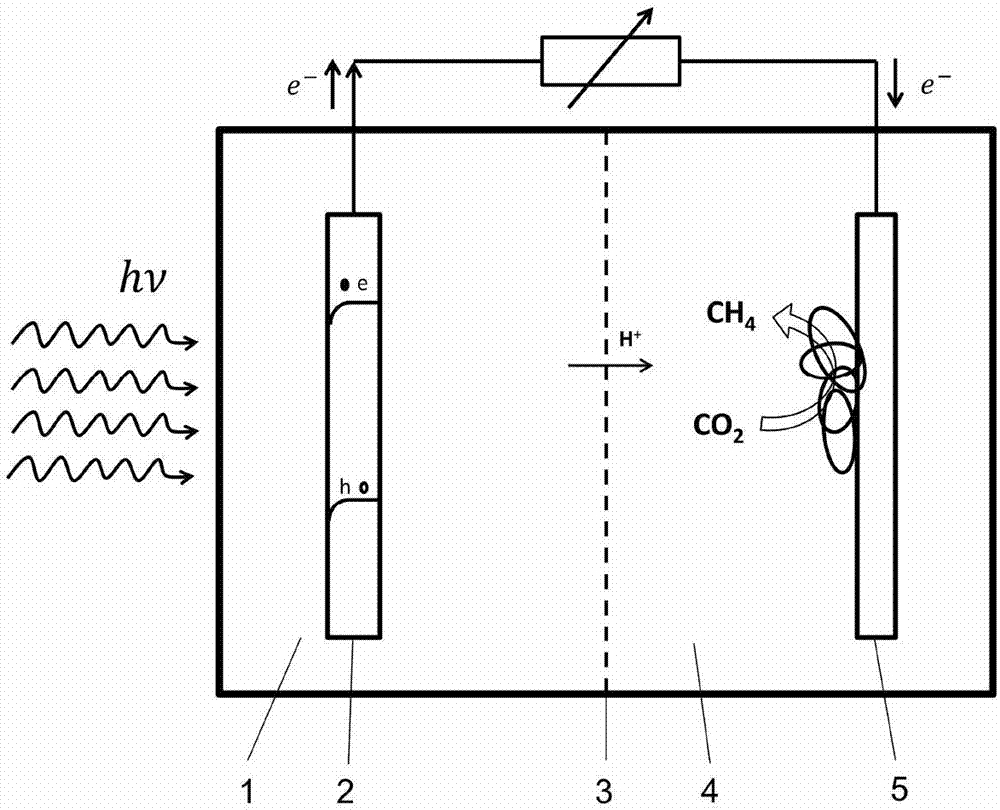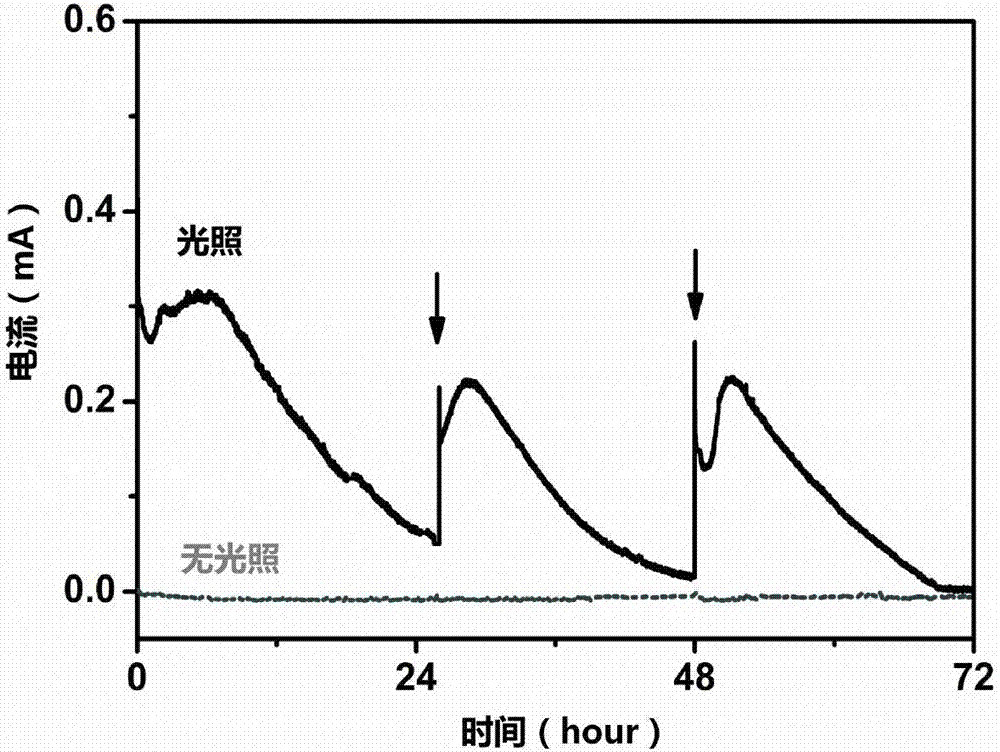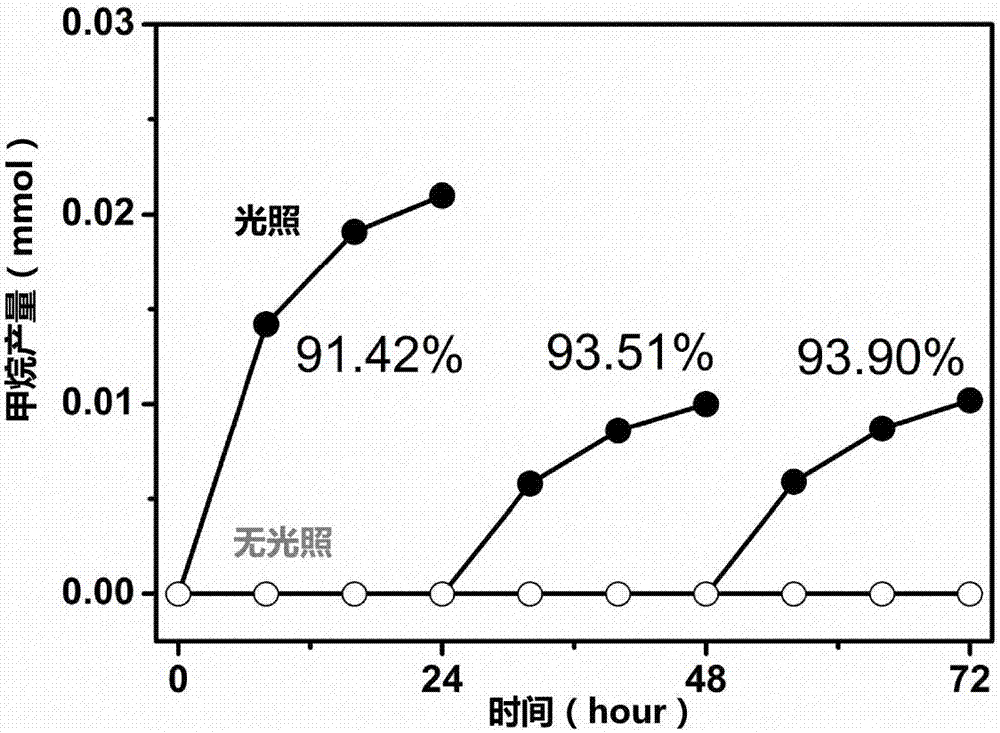System and method for reducing CO2 to produce methane through microorganism/photoelectric-coupling
A carbon dioxide and photoelectric coupling technology, which is applied in the field of methane-producing systems, can solve the problems of frequent adsorption and desorption, high degree of automation, and high cost, and achieve good application prospects, environmental protection, energy saving, emission reduction, and low cost.
- Summary
- Abstract
- Description
- Claims
- Application Information
AI Technical Summary
Problems solved by technology
Method used
Image
Examples
Embodiment 1
[0029] see figure 1, a microbial / photoelectric coupling reduction carbon dioxide methane production system, comprising an anode chamber 1 and a cathode chamber 4, the anode chamber 1 and the cathode chamber 4 are respectively provided with an anolyte and catholyte, between the anode chamber 1 and the cathode chamber 4 A cation exchange membrane 3 is provided, wherein: a photoanode 2 is also provided in the anode chamber 1; the photocatalyst on the photoanode 2 adopts an n-type semiconductor, and the conduction band potential of the n-type semiconductor is lower than CO 2 / CH 4 The redox equilibrium potential, meanwhile, the valence band potential of n-type semiconductor is higher than that of H 2 O / O 2 redox equilibrium potential; the cathode chamber 4 is provided with a biocathode 5, and the surface of the biocathode 5 is attached with electrochemically active methanogens; the anolyte is water or waste water containing organic matter; the catholyte is composed of inorganic...
Embodiment 2
[0032] Embodiment 2: a kind of method that microorganism / photoelectric coupling reduces carbon dioxide to produce methane, comprises the steps:
[0033] 1. Reaction system construction
[0034] The reaction system includes an anode chamber 1 and a cathode chamber 4 , and a cation exchange membrane 3 is arranged between the anode chamber 1 and the cathode chamber 4 . An anolyte and a catholyte are respectively arranged in the anode chamber 1 and the cathode chamber 4, and the anolyte is water; the catholyte is a mixed solution containing inorganic carbon source, nitrogen source, inorganic salt, buffer solution and trace elements; the catholyte is in this Adopted in the embodiment: 0.1~0.3g / LKH 2 PO 4 , 2~3g / L Na 2 HPO 4 , 1~4g / L NaHCO 3 , 0.2~0.6g / L NH 4 Cl and 0.1~0.2g / L CaCl 2 2H 2 A mixed solution of O and 5-15g / L trace elements. Among them, trace elements include: 2.0~5.0mg / L riboflavin, 2.0~5.0mg / L p-aminobenzoic acid, 1.0~3.0mg / L vitamin H, 1.0~3.0mg / L vitamin B ...
Embodiment 3
[0040] Embodiment 3 A method for microbial / photoelectric coupling reduction of carbon dioxide to produce methane, comprising the steps of:
[0041] 1. Reaction system construction
[0042] The reaction system includes an anode chamber 1 and a cathode chamber 4. An anolyte and a catholyte are respectively arranged in the anode chamber 1 and the cathode chamber 4. The anolyte contains organic waste water, specifically: 5-50g / LKOH and 2-10g / L A mixed solution of glucose; catholyte is a mixed solution containing inorganic carbon source, nitrogen source, inorganic salt, buffer solution and trace elements; a cation exchange membrane 3 is arranged between the anode chamber 1 and the cathode chamber 4.
[0043] 2. Prepare the photoanode; the photocatalyst on the photoanode 2 adopts n-type semiconductor, and the conduction band potential of the n-type semiconductor is lower than that of CO under any pH condition 2 / CH 4 The redox equilibrium potential, meanwhile, the valence band pot...
PUM
 Login to View More
Login to View More Abstract
Description
Claims
Application Information
 Login to View More
Login to View More - R&D
- Intellectual Property
- Life Sciences
- Materials
- Tech Scout
- Unparalleled Data Quality
- Higher Quality Content
- 60% Fewer Hallucinations
Browse by: Latest US Patents, China's latest patents, Technical Efficacy Thesaurus, Application Domain, Technology Topic, Popular Technical Reports.
© 2025 PatSnap. All rights reserved.Legal|Privacy policy|Modern Slavery Act Transparency Statement|Sitemap|About US| Contact US: help@patsnap.com



